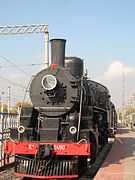Russian locomotive class Ye
| Russian class Е [Ye] | |
|---|---|
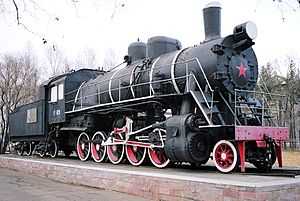 Еа-629 (Ел-629) as a monument in Ussuriysk (Primorsky Krai) | |
| Specifications | |
| Power type | Steam |
| Builder | Baldwin Locomotive Works; American Locomotive Company; Canadian Locomotive Company |
| Build date | 1915–1918; 1943–1947 |
| Total produced | 3,193+ |
| Configuration | 2-10-0 |
| UIC classification | 1′E h2 |
| Gauge |
5 ft (1,524 mm) Those remaining in US converted to 4 ft 8 1⁄2 in (1,435 mm) |
| Driver diameter | 52 in (1.321 m) |
| Length | 72 ft 9 in (22.17 m) |
| Weight on drivers | 180,200 lb (81,700 kg) |
| Locomotive weight | 207,700 lb (94,200 kg) |
| Locomotive and tender combined weight | 342,500 lb (155,400 kg) |
| Fuel type | Coal |
| Fuel capacity | 40,000 lb (18,100 kg) |
| Water capacity | 7,000 US gal (26,000 l; 5,800 imp gal) |
| Boiler pressure | 180 psi (1.24 MPa) |
| Firegrate area | 64.7 sq ft (6.01 m2) |
| Heating surface: – Total | 2,594 sq ft (241.0 m2) |
| Superheater area | 569 sq ft (52.9 m2) |
| Cylinders | Two |
| Cylinder size | 25 in × 28 in (640 mm × 710 mm) |
| Valve gear | Walschaert |
| Tractive effort | 51,500 lbf (229.08 kN) |
| Career | |
| Railroad(s) | Imperial Russian Government; Various American railways. |
The Russian locomotive class Ye, and subclasses Yea, Yek, Yel, Yef, Yem, Yemv and Yes (Russian: Паровоз Е; Еа, Ек, Ел, Еф, Ем, Емв and Ес) were a series of 2-10-0 locomotives built by American builders for the Russian railways in World War I and again in World War II. They were lightweight engines with relatively low axle loadings. Due to the Bolshevik revolution in 1917, 200 locomotives were stranded in the United States; these were fitted with wider tires (locomotive driving wheels had iron tires which were heated to expand them, then driven over the wheels so that they shrank into place. By fitting wider tires with a deeper tread width, the effective wheel gauge could be decreased from the Russian standard of 5 feet to 4' 8-1/2", the US standard) to fit the American gauge and were sent to various railroads. The locomotives were nicknamed "Russian Decapods."
A number of locomotives were acquired by the Finnish railways (class Tr2)[1] and by the Republic of China (class DK2)
World War I
Background
When Russia entered the war in 1914, it was dependent mainly on 0-8-0 and 2-8-0 locomotives. What was needed were locomotives with high adhesive weight (and thus tractive effort), which could only be provided by a locomotive with 10 drive wheels, but the only one being built, the class E (Russian: Паровоз Э) 0-10-0, was in short supply, with only 100 produced thus far. Another problem was that the 0-10-0's were being produced only at one factory. At this time, Professor N. L. Shchukin, head of the commission of rolling stock, the Ministry of Railways, proposed ordering 400 2-10-0 locomotives from the United States.
Design
Although the production was to be American, the locomotive was designed by Russian engineers. This called for 10 drive wheels, a low axle loading, a large firebox to burn low-grade coal, and an overall similar design to the class Э class 0-10-0. Because the weight of the boiler, particularly the firebox, caused the axle load on some axles to exceed 16 tonnes, it was decided to add a lead pony truck, thus turning it into a 2-10-0. This also allowed a slightly bigger boiler whilst keeping the axle loadings within acceptable limits.
Some people (including Shchukin) would have rather ordered a 2-10-2 locomotive, but it was decided to keep it as a 2-10-0, as its shorter length would allow to fit on smaller turntables. Another reason was that the small drive wheels allowed a wide firebox above the wheels to be nearly as deep as a locomotive with a trailing axle.
The cylinders were originally planned to be 630 mm stroke by 700 mm bore, but because America uses inches, the designers changed it to 635 mm (25 in) stroke by 711.2 mm (28 in) bore. It was originally planned to use plate frames, but since that would take time away from production in setting up the equipment in American factories, it was decided to use bar frames.
It is worth noting that at the same time, Russian designers were also planning for a tandem compound 2-10-0 and 0-10-0, and ordinary 0-10-2 and 0-12-0 to be produced at home, but the orders were never implemented due to the factories being at the limit of their capacities.
Diagrams showing the basic dimensions of four models...
-
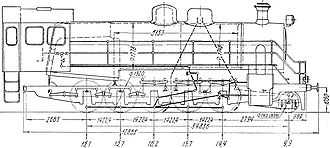
Еф, Ек, and Ес
-

Ел
-

Еа
-
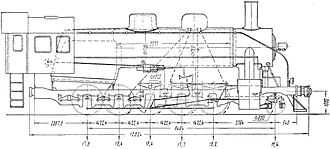
Ем and Емв
The First Order
In 1915, the first 400 locomotives entered production. In Russia, they were given the name of class "Е," with subclasses varying on the city of the manufacturer: Еф for Baldwin built (ф=ph for Philadelphia, Pennsylvania), Ес for Alco built (с=s for Schenectady, New York), and Ек for Canadian built (к=k for Kingston, Ontario).

It is worth noting that the locomotives were manufactured without brakes. This is due to the fact that it was determined to equip these locomotives with Westinghouse brakes, but this did not comply with the requirements of Russian railways. Therefore, the braking equipment was commissioned by the joint stock company of Westinghouse in Petrograd. For this reason, upon arriving in Vladivostok, locomotives were first sent to the main workshops of the Chinese Eastern Railway in Harbin. Here, the locomotives were equipped with brake apparatuses, and prepared to be sent to the railways of the European part of Russia.
Second & Third Orders, and Stranded Locomotives

In 1916, after satisfactory performance of the first engines, Russia decided to order a further 475 locomotives, with minor changes. These were sub-classed as Ел. These locomotives were slightly heavier, with an adhesive weight of 80.3 tonnes
In 1917, Russia again decided to order more locomotives. Baldwin was only able to supply 75 at this time. However, when the United States entered the war in 1917, they decided to aid the Allied effort by producing more 2-10-0s for Russia. About 500 locomotives were ordered. However, production was interrupted by the 1917 Bolshevik revolution, and ultimately only 50 locomotives were delivered. This left 200 locomotives stranded in the US. At this point, the United States Railroad Administration decided to convert them to standard gauge by fitting wider tires, and then distribute them among American railways. The Erie Railroad received 75, the Seaboard Air Line Railroad received 40, the St. Louis – San Francisco Railway (Frisco) received 21, and 22 other railways received lesser quantities. The un-built remainder of the order, 200 locomotives, was canceled.
World War II
Background
After two years of war with Germany, much of the Soviet rail system was in ruins. At the time, much effort had been put into rebuilding the track; however, the hasty nature of the construction meant that it could not support locomotives with axle-loadings of more than 18 tonnes. Around 16,000 engines were destroyed by the various bombings, and the remaining intact engines were either too weak or too heavy. The factories did not have the equipment to produce locomotives, so it was decided to order more from America.
Design
To significantly reduce the amount of work on designing a new engine and speed up the order, it was decided to base the project on the design of the Ел engine. To reduce costs and accelerate production of steam cylinders, brass bushings were used, and the cast iron dome was pressed, and the firebox was now welded. Because of the possibility of the motion locking-up, Zyablova valves were replaced with valves of the Celler type. These valves allowed saturated steam directly into the cylinders while preventing combustion gases from the firebox to enter. The number of tubes for the super heater elements was increased from 28 to 35, raising the superheater area to 76.2 m2 (820 sq ft). The evaporative heating surface of the boiler was therefore decreased to 229.2 m2 (2,467 sq ft) (with the number of boiler tubes reduced to 162). Due to the increase in weight the engine, and the possible damage in transit across the ocean, the thickness of the frame’s sidewalls was increased from 114.3 to 127 mm. For supplying coal to the firebox, tenders were equipped with an HT-1 automatic stoker. In addition, there were a few minor improvements. Otherwise, the locomotives were unchanged.
Subclasses Еа, Ем, and Емв
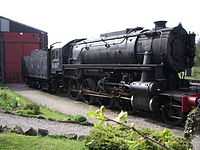
At the conclusion of the third protocol of Lend-Lease in the summer of 1943 (effective from 1 July of that year), the American factories ALCO and Baldwin were given an order for production of more 2-10-0 locomotives based on the Soviet designers' drawings. But American factories were not ready to start manufacturing these engines until the end of the year, which, due to the high demand for steam locomotives, the Soviet Union was forced to order the 150 (later the order was increased to 200) of military-type 2-8-0 of the S160 series locomotive (on Soviet roads they were designated Series Ша). It is noteworthy that these engines were based on the Ел locomotives, built between World War I and World War II, having similar features such as the high location of the boiler.
In 1944 the first steam engines of the Е series, which was given index "a" (U.S.), resulting in the designation of Еа. The numbers of locomotives built by ALCO began at #2001 and the Baldwin built locomotives at #2201. In September the same year, the first Baldwin built locomotive (Еа-2201) was sent to the pilot ring VNIIZhT which was tested until October. In the course of the tests, it was found that forcing the boiler to 70 kg/m2 (0.00069 MPa; 0.100 psi), a cutoff of 60% and at a speed of 19.6 mph (31.5 km/h), the engine could develop 36,080 lbf (160.5 kN) of tractive effort. It was also found that the locomotive could achieve 1,920–1,950 hp (1,430–1,450 kW), which was a 20–25% increase compared to the World War I engines (1,400 hp or 1,000 kW). The improved performance was achieved through improved boiler and the use of mechanical stoker. The temperature of superheated steam was typically 572–644°F (300–340°C), and no more than 698°F (370°C).
In 1945 the factories began producing steam engines of this new design, which received the designation of Ем (modernized).
.jpg)
Although the locomotives were designed and built according to Soviet designs, the American plants implemented some of their own technologies, as well as changes in design of individual units. Thus, the plant Baldwin locomotives #2624 to Alco #2200 were issued with rocking grates. Most of the Еа and Ем locomotives were issued with bar frames, but some were released with cast frames, which included not only a sidewall with better fixtures, but cylinders integrated with the support for the boiler, the buffer timber with support for the truck, smaller tender coupling, brackets for balancing the spring suspension and brake support shaft. Also, the last thirteen locomotives built by ALCO, issued in 1947, were equipped with feedwater heaters. These 13 locomotives were given the designation Емв. In 1946, at the Yaroslavl locomotive plant, two locomotives were weighed: one was an Еа with bar frames, and the other was an Ем with a cast frame. It was found that the engine Е-2001, Е-2988 and Ем-3892 have common operating weights which were, respectively, 102.8, 99, 6, and 103.5 tonnes, and the adhesion weight was 91.2, 88.7 and 91.5 tonnes.
The last steam locomotive was Ем #4260 (Some sources say #4250), built by Baldwin for Soviet railways, and delivered on August 27, 1945, and that was when Baldwin stopped producing locomotives for the Soviets, followed by Alco in 1947. Overall, no less than 2,047 Russian decapods were built for the Soviet Union between 1944 and 1947. However, the recorded numbers of the locomotives built and delivered varies between US and Soviet sources. Thus, according to Vitaly Rakov, only 2,047 locomotives were built, of which 1,622 were of class Е, 412 were of class Ем, and 13 were of class Емв. Ем locomotives #3621-3634 were not delivered. Peter Klaus pointed out that the USSR did not make engines with serial numbers USATC #4878 (Е-2378), 5908, 5938, 5940–5942, 6734, and 10060–10086, and according to R. Tourett, 47 of the 2110 steam locomotives built were not sent to the USSR.
Post-War Tr2 Finland

The State Railroads of Finland purchased 20 American Decapods after World War II - these were originally built for the Soviet Union, but never delivered to them. Of the 20 engines, 10 were made by Baldwin, 10 by Alco. Since they were originally built for the USSR, they had the correct gauge for Finland, too (1,524 mm (5 ft) exactly). One (Alco # 75214, 1947) is preserved at the Finnish Railway Museum in Hyvinkää, Finland.
The locomotive had Finnish designation Tr2 (Tavarajuna, Raskas - Freight Train, Heavy) and nickname Truman after US President Harry S Truman. They were delivered in 1947 and phased out 1969 as diesel and electricity superseded steam on Finnish railways.
Surviving Locomotives
|
- SLSF 1632 - Belton, Grandview and Kansas City Railroad, USA.
- Еа-2026 - Depot Hrechany, Ukraine.
- Еа-2533 - Depot Sibirtsevo,Vladivostok.
- Еа-3215 - Sibirtsevo, Primorye.
- Ем-3753 - Vyazemskaya, Khabarovsk Territory.
- Еа-4160 - Irkutsk.
- Ел-266 - Railway Museum in Ulan Bator, Mongolia.
- Ес-311 - Museum at Oktyabrskaya, railway station, Shushary.
- Ел-345 - Brest Railway Museum.
- Ел-534 and Еа-2201 - the Central Museum of Railway Transport, Russian Federation at Varshavsky Rail Terminal, St. Petersburg
- SAL 544 - North Carolina Transportation Museum, USA.
- SLSF 1621 - Transport Museum in St. Louis, United States.
- SLSF 1625 - Museum of the History of American Railroads in Dallas, USA.
- SLSF 1630 - Illinois Railway Museum in Illinois, USA.
- Еа-2371 - Tashkent Railway Museum.
- Еа-2441 - Technical Museum of AvtoVAZ, Togliatti.
- Еа-2450 - Moscow Railway Museum at Rizhsky Rail Terminal
- Еа-3078 - Novosibirsk Museum of railway equipment.
- Еа-3510 - Rostov Railway Museum Station Gnilovskaya.
- Ем-3635 and Ел-4000 (?) - Museum near the station Lebyazhye, Leningrad region.
- Tr2-1319 - Finnish Railway Museum in Hyvinkää.
- Ес-350 - Chelyabinsk.
- Ел-629 - Ussuriysk.
- SLSF 1615 - Rocket Park (Missile Park) at Altus, Oklahoma, USA.
- Еа-2325 -
- Еа-2885 - Station Komsomolsk-sorting.
- Еа-3070 - Circum-Baikal railway.
- Еа-3220 - Station Zilov, Chita Region.
- Еа-3246 - Station Tynda, Amur region.
- Еа-3306 - Vladivostok railway terminal, as monument "To military feat of railway workers in Primorye region during WWII"
- Ем-3884 - Station Tommot, Yakutia.
- Ем-3931 - Station Vyazemskaya, Khabarovsk Territory.
- Ем-4249 - Vikhorevka, Irkutsk region.
- Ел-4729 - Nizhneudinsk, Irkutsk region.
- Еа-5052 (?) - Station Lena, Irkutsk region.
See also
- The Museum of the Moscow Railway
- Varshavsky Rail Terminal, Home of the Central Museum of Railway Transport, Russian Federation
- Rizhsky Rail Terminal, Home of the Moscow Railway Museum
- History of rail transport in Russia
References
Sources
- Hollingsworth, Brian (2000). The Illustrated Dictionary of Trains of the World. London: Salamander Books Ltd. pp. 136–137. ISBN 1-84065-177-6.
- Rakov, V. A. (1995). Локомотивы отечественных железных дорог 1845—1955 (2 ed.). Moscow: Транспорт. ISBN 5-277-00821-7.
- Tourret, R. (1977). United States Army Transportation Corps Locomotives. Tourret Publishing. ISBN 978-0-905878-01-0. Unknown parameter
|ссылка=ignored (help) - Sucmen Veturit. (1975). Valticnrautateichen hoyryerturit. Malmö. Unknown parameter
|том=ignored (help) - Леонид Макаров. (2005). Декаподы. Техника молодёжи. Unknown parameter
|номер=ignored (help) - Альбом схем паровозов и паспортов. Moscow: Фабрика наглядных учебных пособий НКПС (типография «Гудок»). 1935. Unknown parameter
|ответственный=ignored (help)
External links
| Wikimedia Commons has media related to Russian locomotive class Е. |
- "Suomen Rautatiemuseo - Kalustogalleria - Tr2 perustiedot" [Finnish Railway museum - stock gallery - Tr2 locomotive]. www.rautatie.org (in Finnish).
- The Museum of the Moscow Railway Photographs
- Lenin's Funeral Train Photographs
- Paveletsky Rail Terminal Official site
- The Moscow Railway Museum at Rizhsky Rail Terminal, Moscow
- Report on a visit to the Varshavsky Rail Terminal, St.Petersburg
| ||||||||||||||||||||||||||||||||||||||||||||||||||||
| ||||||||||||||||||||||||

.jpg)

